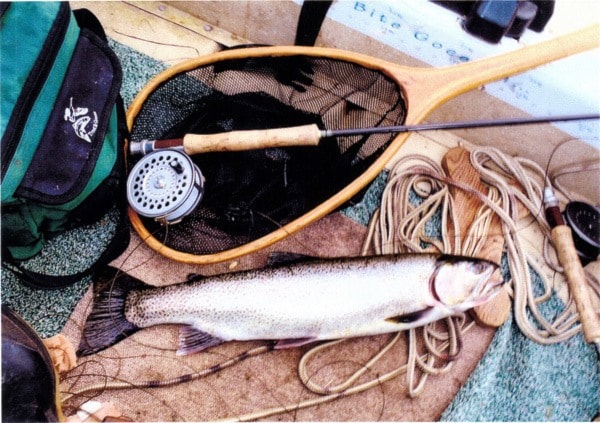One has to be cautious when suggesting there are some happy consequences of prolonged winter – come spring – absent summer. I have found myself sitting on the shore because of unrelenting winds and storms, but on the other hand small lake fishing has been better than usual with the quality of the trout holding up throughout out the month of July.
Insect hatches are late, but you know they are the terrestrial stage of popular trout food. The aquatic stages of many insects are still swimming around the bottom of the pond where trout continue to feast on them. Case in point – I have yet to witness a good sedge hatch, but I have been enjoying some excellent fly fishing with patterns of the pupae stages of this class of insects.
Dragon flies are another class of insect that time their emerging as adults with emerging cycles of many smaller prey species. To this end, dragon fly nymph patterns are continuing to producing well when fishing with sinking lines in deep water.
I fished Spider Lake a couple of weeks ago and kept one prime trout of about 14-inches in length. It neatly fit what is a one-meal fish size for two people. Upon cleaning the fish I noted the stomach was empty and the body fat on the intestine was almost A red as was the flesh of the fish. When we had it for dinner we both remarked on the excellent quality of the flesh for a mid-summer trout. It would seem to me that the quality of the flesh for a summer fish is a result of cool summer weather – thereby resulting in cooler water temperate in our lakes.
My last lake trip was on Wolf Lake near the base of Mount Washington. It is quite a large, long, narrow lake between Mount Washington and Centennial Hill and is about 5km long, with boat launches at both ends. I launched at the north end and rowed south along the western shore searching for signs of feeding trout.
It was a cool day with a brisk breeze. There were two shore fishermen at the launch site; a couple in a canoe and one other boat fishing off the big slide near the middle of the lake. It was near the middle of the lake that I noted some small rises near some old submerged stumps that stood well out into the lake from the shoreline. It was an invitation to put down an anchor a cast towards the submerged stumps.
On my first cast a small cutthroat of about 10-inches took my fly. I resisted the temptation to kill it and see what it was eating, A few casts later I took a respectful cutthroat in the 13-inch class. I killed it and noted three sedge pupae it the stomach after I cleaned it and put it on ice. The flesh was a pale pink.
During the next couple hours of pleasant fishing with a light green sedge pupae pattern, fished with a medium slow sink line, several fish were caught and two more added to the fish box. The wind had picked up and it was time to call it a day.
After pulling my anchor the boat drifted into deeper water and I put on a small brown leech on a high density wet line. The breeze was moving me along at quite a good clip when there was a heavy strike on the leech pattern.
After what seemed an eternity I netted a large, sleek cutthroat trout that measured over 20 inches – a good trout by any standard. When I cleaned the large trout I noted its stomach was empty. If I caught another large cutthroat in Wolf Lake I would release it because we found the smaller fish to be much better flavoured than the large fish.
My information on the lake suggested that it has a good population of native cutthroats. It is stocked on a regular basis by the Freshwater Fisheries Society plus some natural spawning streams. On the experience of this trip I plan to pay more attention to it the future to this lake. When I fish it again I will launch from the site off Stone Quarry Road at the south end.
Ralph Shaw is a master fly fisherman who was awarded the Order of Canada in 1984 for his conservation efforts. In 20 years of writing a column in the Comox Valley Record it has won several awards.
